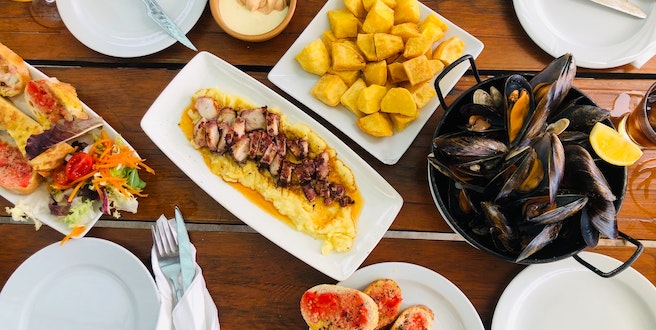Last Updated on February 17, 2023
I have had a fortunate life with a job that allowed me to travel around the world and experience different cultures. And with new cultures comes an introduction to new foods.
From Japanese sushi to Indian curries, many cultural cuisines have spread worldwide. But none less than Spanish tapas. No matter where I went, I could always find a restaurant, cafe, or seaside bar with tapas on the menu. And that is not a bad thing.
Tapas dishes have taken the world by storm. Before tapas, going out for a meal involved the same old three courses: appetiser, main course and dessert. But tapas have changed the dining scene and given us a new way to experience meals: smaller portions with fantastic variety.
The small plates were an instant hit for me, as I find it hard to choose just a few items on a menu – I want to try them all!
Isn’t Tapas just Another Name for an Appetiser?
View this post on Instagram
While an appetiser is savoury and meant to stimulate your appetite, tapas, on the other hand, can be savoury or sweet and consumed anytime. Tapas provide a variety of flavours on your table, and one of the biggest perks of tapas is that you eat them with your hands!
There are many stories of where tapas came from (which I will get to later), but the one thing every story agrees on is that they were a snack, more often enjoyed by peasants.
The fact we eat tapas by hand makes us love them so much more, as eating by hand brings a closer connection with our food. Getting our hands a little messy and licking our fingers is otherwise seen as bad manners, I know. But who cares when the stomach is growling and the tapas are so tasty? And on another note, does the word appetiser sound pretentious to you?
You may also like: 7 Differences Between Tapas And Pintxos
Why Choose Tapas?
View this post on Instagram
A tapas menu broadens the dining experience by giving you an abundance of choices and flavours to boot. Once just slices of chorizo, olives, and bread, tapas have evolved and most tapas dishes are not Spanish at all.
These small plates used to present cured meats or bravas (potatoes in a sauce), but today, tapas food have become a fusion of tastes and cultural cuisine. The tapas menu includes foods like tuna tartar, popcorn prawn brioche rolls, or crispy pork belly with apricots.
It’s the variety and smaller portions I love. As a gourmand, I like trying new things and found it great to have such a large selection of different foods when I was travelling. During my travels, I came across one of the best tapas menus I’ve seen at a cosy restaurant in Melbourne Australia.
How Tapas Spread Around the World
View this post on Instagram
Our world has become “smaller” with increased travel and social media, which has opened up our eyes to the myriad of cultural cuisines. And it seems that each country has its time in the sun. Years ago, it was Chinese food, then Japanese sushi and Indian curry, but now it’s all about Spanish tapas.
Though they have been around for centuries, they have only become popular in the last few years due to social media. For better or worse, people photographing food and posting pictures on Instagram has become part of the dining experience. Smaller plates of food covering the table not only give the dinner a wonderfully diverse meal, but they make great photos too. And as delicious as traditional tapas are, the influence of social media has helped them spread and evolve into the tapas we love today.
Takeaway: The word tapa comes from the Spanish word “taper” which means to cover – a lid. The most common theory of how tapas came about is connected to bartenders. When they’d serve meat on small plates, they’d cover the drinks so flies wouldn’t get in.
One of the most popular stories connected to the origin of tapas has a lot to do with the King Alfonso of Spain. Namely, the King stopped at a tavern on a windy day. When he ordered a drink, the bartender put a slice of meat on it to prevent the dust from getting in his glass. When the King called for another round he shouted “one more tapa”.
Another popular account talks about King Alfonso X of Castile. When the King was ill, he ate small amounts of food alongside his wine (which was his therapy) to prevent intoxication. After the King recovered, he decreed that small portions of food were to be served with all drinks, to prevent public drunkenness.
Regardless of the origins of tapas, this style of dining is growing in popularity by the day. Today, you will find tapas-style restaurants almost everywhere in the world, connecting colleagues, families, and friends who happily share small plates of snacks.
You may also like: Best 4 Places to Visit in Spain for Foodies
 Travel for Food Hub The Food Blog for Travel Lovers
Travel for Food Hub The Food Blog for Travel Lovers
















